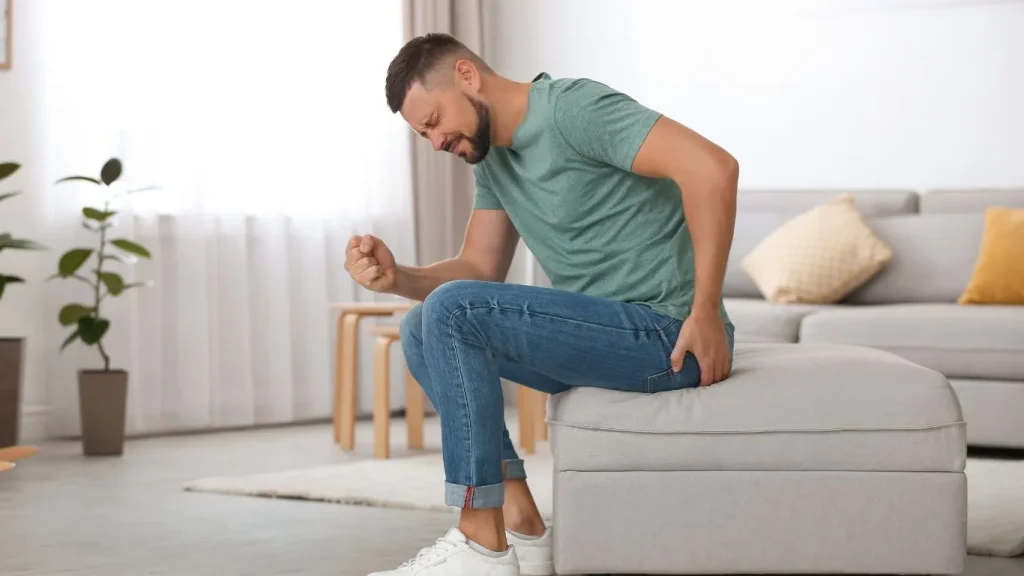Sciatica refers to pain that follows the course of the sciatic nerve, extending from the lower back through the hips and buttocks and down each leg. This discomfort typically arises when the sciatic nerve becomes compressed or irritated, often due to conditions such as a herniated disc, bone spur on the spine, or spinal stenosis. Symptoms of sciatica can include pain of varying intensity, along with numbness, tingling sensations, or weakness in the affected leg.
This condition is common and can range from mild discomfort to severe pain that may interfere with daily activities. in this article we will talk about tips to reduce sciatic nerve pain
How to reduce sciatic nerve pain?
There are some tips that will help relieve sciatica pain, including:
Use of hot and cold packs
Using cold packs within the first 72 hours of sciatica symptoms appearing, especially if the pain is due to an injury, can help reduce swelling, which may decrease pressure on the sciatic nerve.
Never apply an ice pack directly to your skin; instead, wrap it in a towel and place it on the painful area for 15-20 minutes each time.
After 72 hours, you can switch to warm compresses. Apply the warm compress for only 20 minutes each time. Heat can relax tight or tense muscles, reducing pain and tension. If you still feel pain after a few days of using heat, you can alternate between ice and heat on the painful area, using whichever treatment gives you the most comfort.
Keep Moving
When we feel pain, our inclination is to sit or lie down, but in cases of sciatica, the best solution is to keep moving. Despite the challenge, it’s important to continue moving to prevent our bodies from weakening and experiencing more chronic pain. Occasionally moving and practicing gentle stretching exercises may be all you need to quickly alleviate sciatica pain.
Physical therapy
Physical therapy can help alleviate pain and pressure on the sciatic nerve and strengthen the muscles supporting the lower back. A physical therapist will create an exercise program, including stretching techniques, that you can perform at home. Lower back pain in the spinal column can be quickly reduced through simple stretching exercises for the back muscles and spine.
Standing hamstring stretch
This stretch can help alleviate pain and tightness in the knee tendons caused by sciatica.
- Place your right foot at hip level or lower on an elevated surface, such as a chair, stool, or step. Bend your foot so that your toes and leg are straight. If your knee tends to overextend, make sure to slightly bend it.
- Lean your body forward slightly toward your foot. The farther you go, the deeper the stretch. Do not push too hard to avoid feeling pain.
- Lower your raised leg backward instead of lifting it upward. If you need help easing your hip, use a yoga strap or a long exercise band around your right thigh and under your left foot.
- Hold for at least 30 seconds, then repeat on the other side.
Scissor hamstring stretch
This stretch can help relax the muscles and tendons around the knee, easing their pressure on the sciatic nerve. It may be beneficial to do this exercise daily.
- Place your right foot about 3 feet behind your left foot.
- Shift your hips forward and push your shoulders backward, ensuring your right hip isn’t farther forward than your left hip. A mirror can help you judge this.
- Place your hands on your hips. You can use a chair for balance if needed.
- Gently lean your torso forward over your front leg by bending at your waist while keeping your back straight. Maintain your weight on your front leg.
- Hold this position for 5 to 10 seconds, then repeat the stretch with the opposite leg. Perform the exercise 3 to 5 times per leg.
Try Over-The-Counter Medications
Some medications can help relieve pain and inflammation. It is recommended to consult a doctor first before starting any drug treatment. Common over-the-counter medications to relieve sciatic pain include:
- Acetaminophen
- Naproxen sodium
- Ibuprofen
Get a Massage
Research shows that massage therapy reduces pain and improves your ability to move your lower back. It also helps increase blood flow, which encourages your body’s self-healing process. You can go to a specialized massage therapist who will focus on back pain and also help you do some stretching exercises during the session.
When should you see a doctor?
If you haven’t experienced improvement after trying the above methods or if the pain persists for longer than six weeks, or if you have numbness and tingling, you should visit a doctor. Orthopedic specialists can provide professional treatment for sciatica, addressing both the pain and the underlying cause related to sciatic nerve damage. Your initial consultation may include a physical examination and imaging, which will help your doctor find the quickest and most effective way to get you back to your active lifestyle.
Non-surgical relief methods that your doctor may use include:
- Prescription medications for pain relief and anti-inflammatory medical treatment plan
- Steroids such as prednisone orally
- Epidural steroid injections
- Nerve blockade (pain relief or anesthesia injection near the nerve root)
المراجع:
- How to ease sciatic nerve Pain. (n.d.). WebMD. https://www.webmd.com/back-pain/ss/slideshow-how-to-ease-sciatic-nerve-pain
- Heitz, D. (2024, February 2). 9 stretches for sciatica pain relief. Healthline. https://www.healthline.com/health/back-pain/sciatic-stretches#scissor-stretch
- Martin, & Martin. (2022, October 7). 7 Tips for fast sciatic Pain Relief | Midwest Orthopedic Specialty Hospital. Midwest Orthopedic Specialty Hospital. https://www.mymosh.com/orthopedics/tips-for-sciatic-pain-relief/

